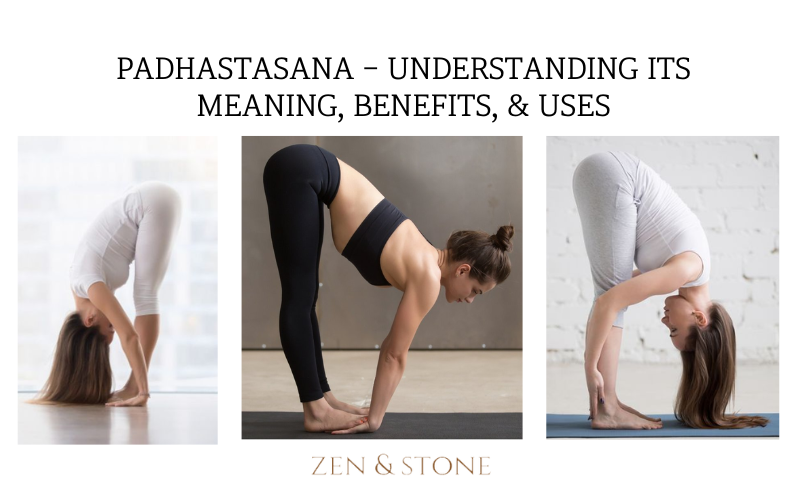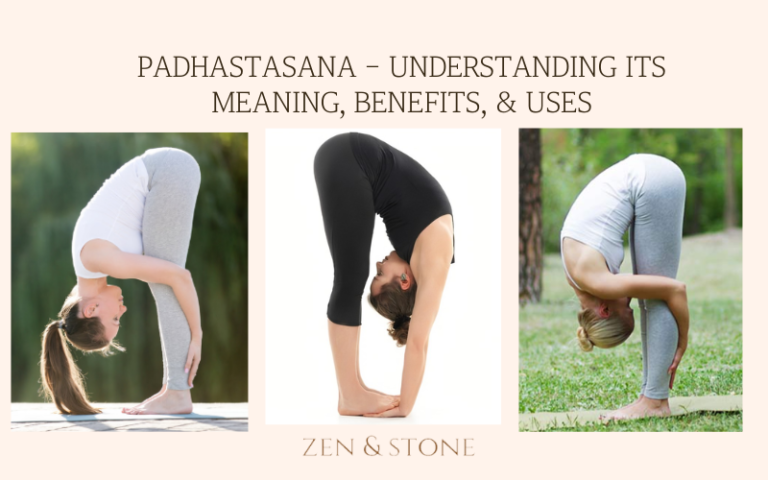
15 Oct Padhastasana – Understanding its Meaning, Benefits, & Uses
Padahastasana, also known as Hand-to-Foot Pose, is a forward bend yoga posture that provides numerous benefits to the body and mind. This pose involves standing with feet hip-width apart and folding forward to place the hands under the feet. Padahastasana is an intense pose that requires flexibility and strength, making it a challenging but rewarding posture to practice.
Understanding Padahastasana is essential to practice it safely and effectively. The pose stretches the hamstrings, hips, and neck muscles, providing relief from tension and tightness. Padahastasana also stimulates the digestive system and improves blood circulation, promoting overall health and well-being. Practicing Padahastasana regularly can enhance flexibility, balance, and concentration, making it a valuable addition to any yoga practice.
Key Takeaways
- Padahastasana is a challenging forward bend yoga posture that requires strength and flexibility.
- Padahastasana provides numerous benefits, including stretching the hamstrings, hips, and neck muscles, stimulating the digestive system, and improving blood circulation.
- Practicing Padahastasana regularly can enhance flexibility, balance, and concentration, making it a valuable addition to any yoga practice.
Understanding Padhastasana
Padhastasana, also known as Hand to Foot Pose, is a forward bend pose in yoga that helps in stretching and strengthening the back and core areas of the body. This pose is a complete inversion as it involves bending forward to touch the toes with the hands, which means the head is below the heart.
To perform Padhastasana, one needs to stand straight with feet together and arms by the side of the body. Inhale deeply, and while exhaling, bend forward from the hip joints, keeping the spine straight. Try to touch the toes with the fingers, and if possible, place the palms on the floor beside the feet. Hold the pose for a few breaths, and then slowly come up while inhaling.
Padhastasana has several benefits, including reducing abdominal fat, correcting digestive problems, increasing height, and giving the thigh muscles a good stretch. It also massages the digestive organs, alleviates flatulence, constipation, and indigestion, stimulates and tones spinal nerves, increases vitality, improves metabolism, and improves concentration.
However, Padhastasana should be avoided by people with lower back injuries, hernia, and high blood pressure. Pregnant women should also avoid this pose. It is essential to practice Padhastasana under the guidance of a certified yoga instructor to avoid any injuries.
Key Uses of Padhastasana
Padhastasana, also known as Hand Under Foot Pose, is a standing yoga posture that offers numerous benefits to the body and mind. Below are some of the key uses of Padhastasana.
Stress Relief
Padhastasana is an excellent yoga pose for relieving stress and anxiety. It helps to calm the mind and reduce tension in the body. By practicing Padhastasana regularly, one can experience a sense of relaxation and inner peace.
Digestive Health
Padhastasana also helps to improve digestive health. It stimulates the digestive system and helps to relieve constipation, bloating, and other digestive issues. It also helps to increase the metabolism, which can aid in weight loss.
Spinal Flexibility
Another key use of Padhastasana is to improve spinal flexibility. It stretches and lengthens the spine, which can help to relieve back pain and improve posture. It also helps to strengthen the muscles of the back and legs, which can improve overall physical fitness.
In-Depth Benefits of Padhastasana

Enhanced Blood Circulation
Padhastasana, also known as Hand Under Foot Pose, is a standing forward bend pose that provides a deep stretch to the hamstring, hip, and neck muscles. This pose is also beneficial for enhancing blood circulation throughout the body. As the head is lowered towards the feet, the blood flow to the brain is increased, which helps to improve mental clarity and reduce stress and anxiety. Additionally, the stretching of the legs and spine helps to stimulate the circulation of blood and oxygen to the lower body, promoting overall health and well-being.
Improved Posture
Practicing Padhastasana on a regular basis can help to improve posture by strengthening the muscles of the back, neck, and shoulders. This pose helps to stretch the spine and release tension in the upper body, which can help to alleviate pain and discomfort associated with poor posture. By improving posture, Padhastasana can also help to reduce the risk of developing back pain and other related conditions.
Mental Clarity
Padhastasana is also beneficial for promoting mental clarity and reducing stress and anxiety. This pose helps to calm the mind and improve focus and concentration, which can be especially helpful for individuals who struggle with anxiety or other mental health conditions. Additionally, the deep stretch provided by this pose can help to release tension and promote relaxation, helping to reduce stress and promote overall emotional well-being.
Practicing Padhastasana Safely
Padhastasana is a powerful pose that offers numerous benefits for the mind and body. However, it is essential to practice this pose safely to avoid injury. Here are some tips to help you practice Padhastasana safely:
1. Warm-up before practicing Padhastasana
Warming up before practicing Padhastasana is essential to avoid any injury. It is recommended to perform some gentle stretches or yoga poses to prepare your body for the intense stretch of Padhastasana.
2. Use props if needed
If you are a beginner or have tight hamstrings, it is recommended to use props such as blocks to support your hands. This will help you to maintain proper alignment and avoid any strain on your lower back.
3. Avoid overstretching
It is essential to listen to your body and avoid overstretching. Do not push yourself beyond your limits, as this can lead to injury. It is better to practice Padhastasana with bent knees than to strain your lower back by trying to touch the floor with straight legs.
4. Engage your core
Engaging your core muscles while practicing Padhastasana can help you to maintain proper alignment and avoid any strain on your lower back. Draw your navel towards your spine and keep your abdominal muscles engaged throughout the pose.
5. Practice under the guidance of a qualified yoga teacher
If you are a beginner, it is recommended to practice Padhastasana under the guidance of a qualified yoga teacher. They can help you to maintain proper alignment and avoid any injury.
By following these tips, you can practice Padhastasana safely and reap the numerous benefits it offers for your mind and body.
Conclusion
Padhastasana, also known as Hand Under Foot Pose, is a beneficial yoga asana that can help improve flexibility, strength, and overall well-being. By practicing this pose regularly, individuals can experience a range of physical and mental benefits.
Physically, Padhastasana can help stretch and strengthen the hamstrings, hips, and neck muscles. It can also improve digestion, promote weight loss, and enhance overall body awareness. Mentally, Padhastasana can help reduce stress and anxiety, improve focus and concentration, and promote a sense of calm and relaxation.
While Padhastasana is generally safe for most individuals, it is important to practice this pose with proper alignment and caution, especially for those with pre-existing injuries or conditions. It is recommended to practice under the guidance of a trained yoga teacher and to listen to your body’s limitations and needs.
Sorry, the comment form is closed at this time.